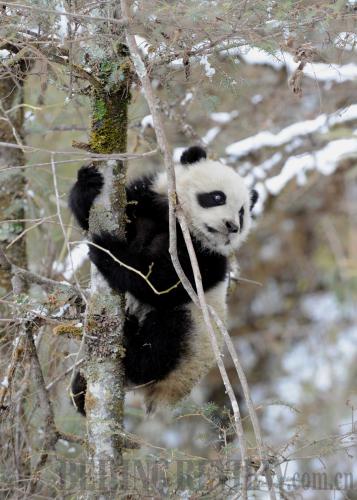|
 |
|
CAPACITY BUILDING: Taotao at a wilderness survival training session on May 11, 2011 (CHEN XIE) |
"Sending artificially bred pandas back to nature after providing them with training will help them integrate with wild pandas. This will be conducive to improving genetic diversity among wild pandas regionally, increasing the wild panda population, and enhancing their survival capabilities," said Wu Daifu, a panda feeder at the Wolong Nature Reserve.
In June 2010, China resumed small-scale training programs for pandas before returning them to nature. The new training focused on the panda cub learning from its mother.
Caocao, a 13-year-old pregnant female panda, was selected to be involved in this program on July 20, 2010. Her baby was going to be trained as the candidate in the program. Caocao was rescued by workers at the Wolong Nature Reserve when she was young. Although she has since lived in captivity, the fact she was raised by her mother in the wild has made her competent in this program.
On August 3, 2010, Caocao gave birth to a baby boy panda, named Taotao, who opened his eyes 35 days after the birth and didn't see a human being since. When the working staff had to interact with Taotao, they dressed up in panda costumes.
Handlers revised training methods based on lessons learned from the fate of Xiangxiang. "As opposed to Xiangxiang's captive-bred environment, Taotao had lived and grown in semi-wild conditions since being very little. This means that its fighting capability and survival skills both improved significantly," Zhang said.
The base had prepared three rounds of training for Caocao's baby going back to the wild. In the first training cycle, it was fed and raised by its mother and learned basic skills such as climbing. In the second training round, the baby was trained to withstand mud-rock flows, snow disasters and rainstorms with its mother, all the while improving its basic survival skills. It learned to fear humans and hide from them. At the last session, it was trained to recognize enemies and its own kind.
From his mother, Taotao soon learned how to find bamboo by himself, even in heavy snow, and how to recognize different animals and climb trees. To help cubs identify natural enemies, handlers made a model leopard, complete with a roaring growl. When Taotao encountered the model during a test in June, he immediately ran for cover.
When he was released on October 11, Taotao was reluctant to leave his cage at first, despite a handler's offer of bamboo stalks. He was eventually coaxed out, and a few minutes later he walked down a mountain path, crossed a stream and disappeared into the dense bamboo forest.
Six pandas, along with their mothers, are receiving field training at the Wolong Nature Reserve, according to Zhang. "We hope to release two or three into the wild each year," he said.
Qi Dunwu, a researcher at the Chengdu Research Base of Giant Panda Breeding, believes it will take at least 50 years for captive pandas to be able to survive in the wild.
"It requires several steps," Qi said. "First, a panda released to the wild must feed itself. Second, it must protect its own territory and find a partner. Third, it must breed. Fourth, its offspring must also breed. It will take about three generations for those steps, as the lifespan of a panda is 15 to 30 years."
Pandas in China
The number of wild pandas in China has increased to more than 1,600. Meanwhile, the number of captive-bred pandas stands at 342.
So far, the country has established 64 nature reserves for pandas, with facilities that have offered effective protection to more than 70 percent of its wild pandas.
(Source: State Forestry Administration)
Email us at: yuanyuan@bjreview.com | 